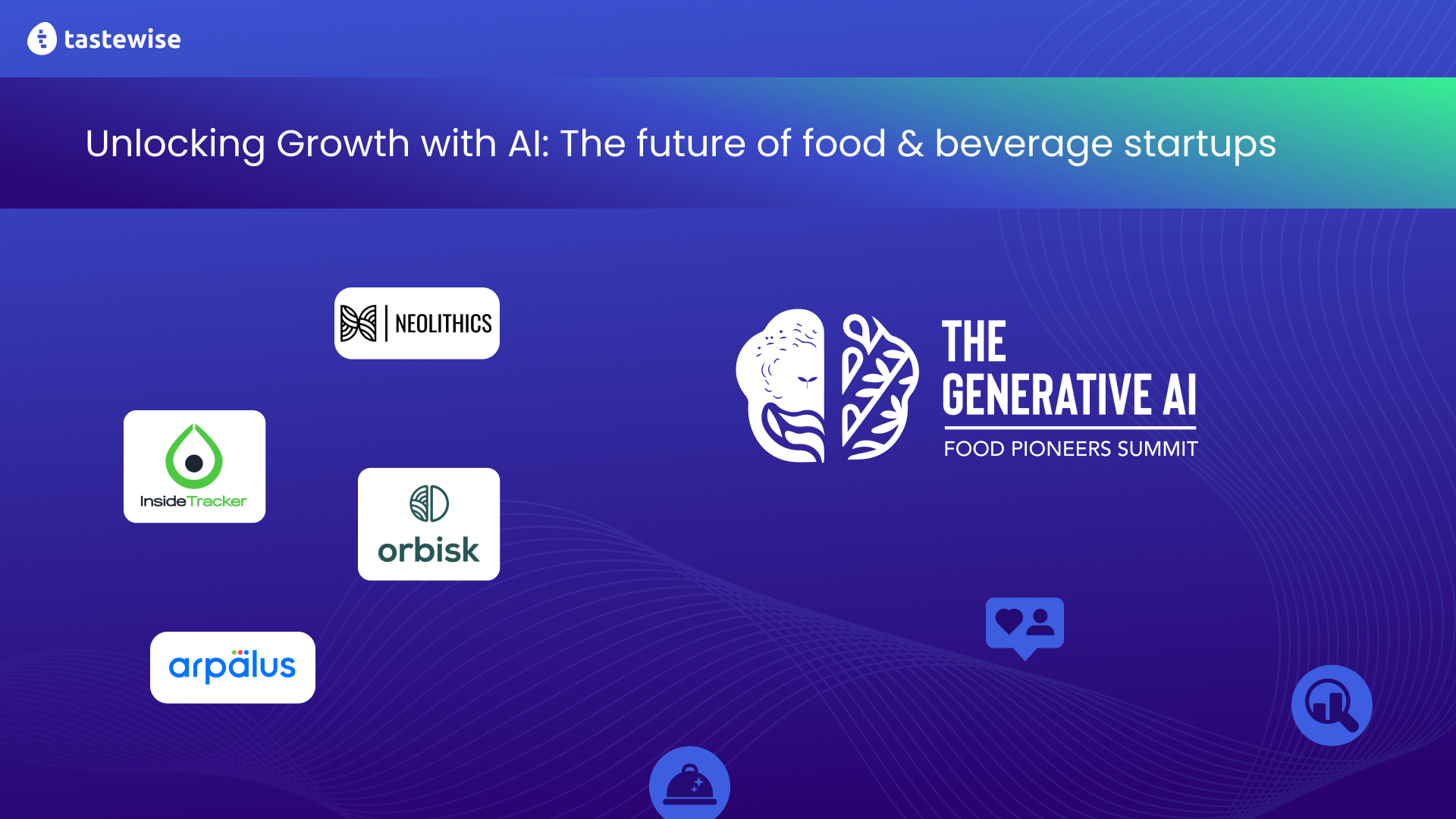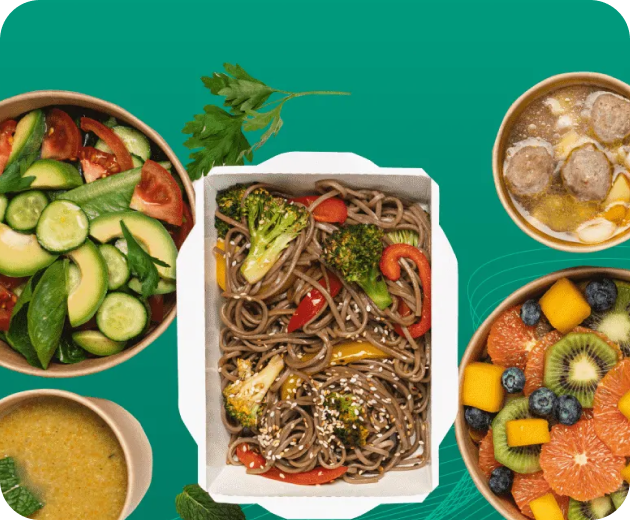Unlocking Growth with AI: The future of food & beverage startups

Join us for a special session featuring select startups in the food tech ecosystem. We’ll hear 5-minute pitches from each about their value-driven applications of AI, pushing us to think differently about the future of food and beverage.
Olaf van der Veen
Co-founder & CEO, Orbisk
David Kat
VP Business Development, Neolithics
Renée Deehan
Senior Vice President, Science and Artificial Intelligence, InsideTracker
Ofir Zilberberg
Co-founder and CEO, Arpalus
[00:00:54]
Renée Deehan: My name is Renée Deehan, and I’m the Senior Vice President of Science and Artificial Intelligence at InsideTracker.
[00:01:00]
Renée Deehan: InsideTracker is an on-market digital health product platform that provides personalized lifestyle medicine prescriptions. These are non-medical interventions that members can apply to improve their health.
We first do this by generating a high-resolution picture of your health by collecting data from standard blood tests, like clinical labs you would get at the doctors, such as your LDL cholesterol or your fasting glucose levels. Then we combine that with fitness tracker data from devices like Fitbit, Apple, and Garmin about sleep, movement, and activities. We can also combine it with information about what you’ve inherited from your family, from DNA information.
We match all of that against the findings from over 7,000 clinical studies curated by experts in the field, like nutritionists or exercise physiologists, into a computable format, meaning it’s machine-readable. Then we use logic to identify the findings from
[00:02:00]
Renée Deehan: those clinical studies that are actually most relevant for you.
The outcome of this is a personalized set of actionable recommendations that span exercise, nutrition, supplements if you’re okay with taking them, and things like recovery, sleep, or meditation. The type of artificial intelligence that we use for this is called knowledge representation and reasoning. This type of AI has not been as widely publicized as things like machine learning or LLMs despite its transformative potential across many industries.
Knowledge representation and reasoning have been around for decades and enable structured access to scattered health care data. This empowers consumers and our members to navigate, retrieve, and understand research findings for informed health decisions. Knowledge representation and reasoning’s capacity to organize and make hundreds of millions of dollars of health care
[00:03:00]
Renée Deehan: research accessible has the potential to revolutionize healthspan optimization and drive demand for data-informed health management solutions.
Currently, our industry, which is health and wellness, can often be paralyzed by analysis. This phenomenon stems from an overabundance of health data without concrete, actionable advice or methods to put this into play. It’s impossible for any human to read, remember, and apply the outcomes of thousands of clinical studies, so artificial intelligence approaches are required for this.
What we do is teach the platform to think like a nutritionist, exercise physiologist, molecular biologist, and health coach all in one to improve
[00:04:00]
Renée Deehan: preventive health solutions. Methods like knowledge representation and reasoning allow us to separate the signal from the noise, which is crucial in an industry cluttered with misinformation and dangerous snake oil at worst. Doctors themselves rarely have the opportunity to monitor the health of their patients in between visits, so technological solutions that capture all these research findings and apply them in a personalized way are essential for accompanying patients on their health journey on a day-to-day basis.
Thank you.
[00:04:52]
Olaf van der Veen: Thank you for having me all over the world as participants. At Orbisk, we strive for zero food waste in the total world food system, starting
[00:05:00]
Olaf van der Veen: at food services, and we do so using the power of AI to quantify food going into waste bins. You can see this waste bin being outfitted with our technology, which includes a waste go underneath and a camera unit on top. This allows us to seamlessly visualize all the food going into waste bins in restaurants.
In the world, 1.3 billion tons of waste occur, with 50% lost in food services. According to renowned projects like Drawdown, this is one of the key problems we should be tackling. We sought a purpose-driven way to leverage our core capabilities and passion. The people making the change in these venues are also the economic benefactors of this change, engaging sustainability and profitability at the same time.
An average restaurant wastes about 100,000 euros of food every year, and we
[00:06:00]
Olaf van der Veen: help them reduce up to 70% of that sum. Because an average restaurant wastes about 100,000 euros of food every single year and we help them reduce up to 70% of that sum. Which is more or less the equivalent of what their operational margin is in these venues as we’re working in a low-margin industry. With a €6K annual subscription fee, our customers get a 12X ROI, reduce 10 tons of food waste, equivalent to 45 tons of CO2 emissions and 17 million liters of water use. The most important person to leverage this technology is the chef or procurement manager of these venues.
We’ll start there, they buying the goods they need, have them delivered to their door, prepare them for their guests, serve them to their guests. And unfortunately, anything for quality or hygiene reasons needs to go to waste, is then lost. And every chef does this with a lot of passion. In fact, I’ve never met a person that loves to waste food but they do start their next day all over again, and that’s loop we are closing using our AI potential. Closing
[00:07:00]
Olaf van der Veen: that loop, allowing them to optimize all of the steps along the way. So we do so by, indeed, outfitting the waste bins with our technology. You can see one of these systems right here behind me. A plug and play installation that doesn’t require anything on your end apart from a power plug. And then we have pictures like these that are quantified by AI. So we have all of these different types of foods going into the waste bin and our AI helps us to really very dedicatedly quantify all of the different types of food in those pictures. Register the weight of those pictures without interfering with the everyday operations. And then turn those individual data points into insights to our interactive dashboards, allowing them to save waste consistently, absolutely seamlessly. Allowing them not only for sustainability and profitability improvements but also compliance towards intensifying regulation they need to do on their food waste level reporting. And we’re working also with AI systems to connect this data to buying, sales,
[00:08:00]
Olaf van der Veen: guest numbers, and circumstantial factors such as weather. Allowing us to really predict how much your guests will be eating tomorrow. I have the good fortune to do it with this awesome team of people from all over the world and this allows us to really change the game, move the needle in that space. So we have built this monitor. We’ve now deployed it in over 600 venues in 35 countries where we seamlessly recognize their food all day, every day. And the state of different insights and allowed us to change our approaches to processes, behaviors, and just the way they provide foods, which doesn’t really impact, I guess, experience. While still improving their sustainability and profitability using the power of AI. So want to know more, I’m most happy to facilitate you. Enjoy this conference and I’m sure we’ll speak soon.
[00:09:00]
Olaf van der Veen: Thank you.
[00:09:15]
David Kat: Hi, there. It’s David Kat at Neolithics in Amsterdam and I’m here to tell you how you can actually make your processes a lot more efficient and a lot more sustainable. Because the way we’re dealing with our foods is insane. Over 40% of the food that we produce is never consumed. And if we’re looking at fruit and vegetables, the quality control that is used is really destructing a lot of products. And still, after all the blood, sweat, and tears, and all the food that is lost, still the claims are very high of customers, retailers, that are not accepting the fruit and the vegetables. and what Neolithics does is
[00:10:00]
David Kat: we solve that. We are basically the mind readers of fruit and vegetables. We look into the fruits without touching it. We use lights in different frequencies to distinguish all the elements that make up the ripeness of a fruit, and the quality of a fruit, and whether it may have diseases. And we’re able to do that without touching the fruits, without destructing, which is a very large part of the current quality control process. We have the hardware kind of look like this. There’s different manifestations of the hardware. We’re really a software company. Because what we do is we take an image of a, for example, a blueberry, in this example, and we look into the delicious fruit. And there, we see the acidity or what the
[00:11:00]
David Kat: sugar levels are, or the breaks, or the other measures that you may or may not know about. But actually make up the quality of the fruits that you will be eating tomorrow for breakfast. And doing this, because your breakfast has such a wide variety, we need to fit into the production and operational approach of our customers. So we do not care, we do not mind, if it’s a large or small facility, if they’re using big boxes or even containers. Because we can get away from sampling and we get into full integrated scanning of the entire quality control in the production stream. Like I said, we have different devices that actually achieve that all the way up to full containers full of grapes.
[00:12:00]
David Kat: But the key is that it’s very easy to start with Neolithics. We have a device that we can bring to a facility like a [inaudible 00:03:09] house or a distribution facility where in your existing operations we look into the products and we read its minds. The most important thing in reading its mind is that it actually helps you build a profitable business case and that’s what we’ll help you do. And eventually, Neolithics is software-driven, so for a monthly subscription fee, you get the hardware and you get the software to create stellar ROI in your production process.
This technology is scientifically extremely intricate and it’s really it’s bleeding edge. But for the users, be they quality control
[00:13:00]
David Kat: or even be actually automated, it’s really very easy to use. And we needlessly fit into the existing operational infrastructure, which is really important in novel technologies. We have plenty of use cases for our customer, but the real thing that we want to do, of course, is get in to use cases with you. Because the impact of preventing food waste, not destructing anymore, and really understanding the quality, is essential.
Like I said, 40% of all the food is never consumed, 11% of all the greenhouse gas emissions are caused by food that is never eaten. There is no time to waste that food anymore, no time to actually make up for the biodiversity loss, the loss of water, the hunger, the [inaudible 00:04:46]. That is caused by processes in the food system that are inefficient and truly no longer of this day and age. So there is no time to waste.
[00:14:00]
David Kat: Take a look at Neolithics and we would love to help you repair this food system for a healthy and appetizing fresh fruit supply. Thank you very much.
[00:14:29]
Ofir Zilberberg: My name is Ofir. I’m the CEO and founder of Arpalus.Arpalus is an Israeli company based in Israel and has a subsidiary in the US and our whole mission is to help brands, retailers, and data providers to boost their sales by maximizing their on-shelf availability.
We’re doing it using a very unique technology, real-time computer vision, and augmented reality. We’ve incorporated in 2019. We will have our
[00:15:00]
Ofir Zilberberg: patent in 2024, this year, and we have a team of 20 employees and growing. Our reason to exist is that CPGs and retailers have a huge, huge problem. Their products in most cases are not seen, leading to a $1.8 trillion global annual loss challenge.
But today’s solutions are very old, whether these are solutions that are totally manual, like going through stores and checking with them maybe what is going on on the shelf or old computer visional barcode scanning solutions.
And what we have brought to the market is a simple app that helps employees to quickly analyze and collect valuable in-store data. And this is how it works. You have your app. An employee just aims the camera toward the shelf, any shelf, and hits the start scan button.
Our algorithm is analyzing what is going on on the shelf immediately and in
[00:16:00]
Ofir Zilberberg: real time and with no connectivity. So you can see here the rectangles and this field just below are marking specific identification of a UPC or Q. The coverage is really to easy to understand, self-explanatory.
The employee can easily monitor and navigate what is going on and what was scanned and what was not scanned. And within seconds, they can cover an entire shelf. We cover metrics from out-of-shelf to planogram compliance to price and promotion to assortment and so on.
We have two SLAs. The first one is real time. You get a full report of planogram compliance and what is going on on the shelf and the key action items of what you need to do.
[00:17:00]
Ofir Zilberberg:The second SLA, which I will present in the next few slides, is simply dashboard.
You collect all the information and then, after you get to your office, it can be after an hour or two or 24 hours, you get a lot of information.
And in terms of our coverage, we have hundreds of thousands of scans under our hood at hundreds of stores. Our average time to scan one bay is seven seconds, very high accuracy. We see very nice results when it comes to time saving, sales lift, and so on.
Our NPS score is very high. And the usage is extremely fast and self-explanatory. When you scan a store, everything happens on the device. You don’t need any access points, Wi-Fi, or whatsoever. Real-time results and whenever the smartphone is connected to the Wi-Fi system, then the analytics dashboard and the cloud environment are being updated.
So planogram compliance. You get a very nice and clean sweep
[00:18:00]
Ofir Zilberberg: image and just above it you can see what is misplaced, what is in place, and what is missing with an automatic face detection for GDPR reasons and also for privacy. It will create realograms from every scan.
So, by placement, SKU by placement and number of shelves, the size, the XY, and also the voids. These are key metrics that simply take the physical shelf and transform it into a digital replica that actions can be taken upon. Another thing that we are doing really exciting with the data is integration between the computer vision capabilities and sales data.
And within this intersection, we can see very nice things like predictions or what is being seen
[00:19:00]
Ofir Zilberberg: on the shelf but you’re selling so little or few items out of it. So many action items can be tried from this. Our technology and being patented is really defensible as we use edge computing, real-time.
Our data labeling simply will reduce all the friction. We can go up with the CPG or retailer within a few days, or tops one week, and cover the entire category and assortment using the App Store or Google Play. So it’s very scalable.
The accuracy levels are very high. There is no stitching or no very high-intensive training your label in order to take snaps or images. Simply zoom in, zoom out, right-to-left, left-to-right. It doesn’t really matter. We cover it all. So you can just scan, you can go back, you can
[00:20:00]
Ofir Zilberberg: cover empty spots. The usability is really nice. And what is, maybe less very exciting is that the business model is becoming extremely easy -so simply. Just per scan or per store visit or per store, per month.
Very simple pricing model. The combination of computer vision and AI has never been so easy and super exciting. And this is what we are doing for PPGs and for the retail space as a whole.
Thank you very much.




